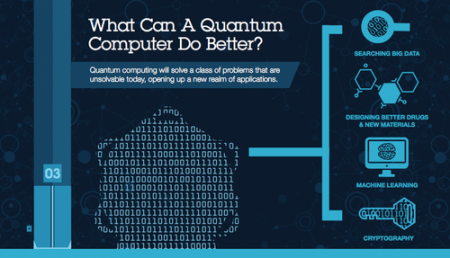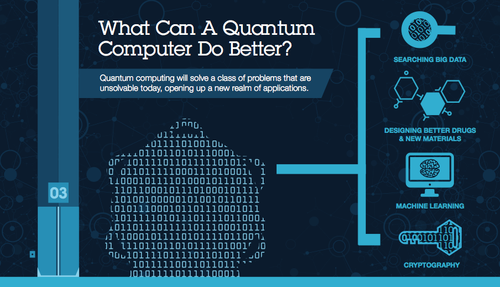May 6, 2015 – Quantum computing has seen three really interesting announcements in the last few weeks. First it was IBM announcing two critical advances with new quantum-bit circuit design and quantum error detection. Second it was Georgia Tech Research Institute and Honeywell International announcing a new ion trap architecture to increase the density of qubits.
A brief explanation of qubits is warranted here. Quantum computing’s equivalent to the data bit is the qubit. A data bit can be a 0 or 1 representing an “on” or “off” state. A qubit on the other hand exists in a state of superposition. That is it can be both 0 and 1 at the same time or be somewhere in between. If you can’t get your head around what this means (see the Dilbert cartoon below) think of baking a pie and the steps required in the recipe. The process you follow is very much bit-based assembling the ingredients and then following a linear process to completion. Not so with qubits which would assemble ingredients and bake the pie all in the same moment.
The third announcement from a Cambridge, United Kingdom company, Cambridge Quantum Computing Limited (CQCL) highlighted the release of the first DOS equivalent for quantum computers.
For younger readers of this blog you may not recognize the term DOS. It stands for Disk Operating System. The most commonly known version appeared when Microsoft delivered MS-DOS for the IBM Personal Computer. DOS continues to exist to this day lurking under the covers of every new MS-Windows operating system release. And DOS is to computers as saints are to the Catholic Church and its congregants. In the case of the latter saints intercede between God and humanity. In the case of DOS it intercedes between the main processing chip on the computer and the software and devices like the hard drive or random access memory. DOS makes the handshake seamless when you type on a keyboard. DOS makes it possible for you to see your work on a display.
Up until now a standardized operating system for quantum computers did not exist. But CQCL using a D-Wave quantum computer, touted as the first commercial quantum computer, has created t|ket>, the first commercial operating system for the technology. With a standard operating system programmers will now produce quantum applications to seamlessly interface with different quantum computing devices. No more one off problem solving calculations using a few qubits.
In a recent Newsweek article, Kevin Maney writes “this technology will make the microprocessor in your laptop seem as sophisticated as a booger.” He calls it a quantum leap “like riding a horse one day and getting into a fighter jet the next.”
When you look at the three announcements you begin to realize just how much closer we are to a quantum computing revolution. In the past you would read about a few advances over a year. Now they seem to be coming out weekly. We are within reach of the quantum computing revolution now. And if you think artificial intelligence on silicon using older computing architecture was problematic, you may find quantum artificial intelligence exponentially more so. As Maney states one quantum computer “will be smarter than your whole department.” Quantum computers will have an enormous impact on those in the computer security business. It will change the speed in which we analyze large data sets. It will help us speed up invention in a wide range of science and technology fields. And it will change our relationship with computing technology forever.






















[…] [from: https://www.21stcentech.com/quantum-computers-dos/%5D […]
[…] the scope and importance of Quantum Computing OS is essential for grasping its potential impact on various industries and scientific disciplines. […]